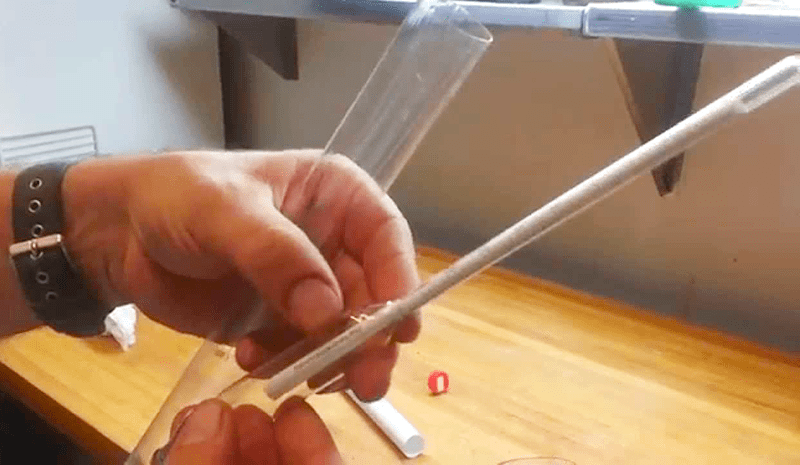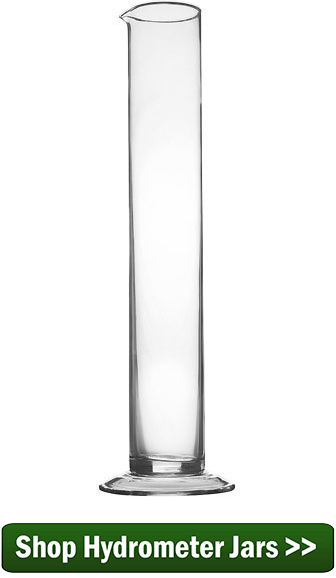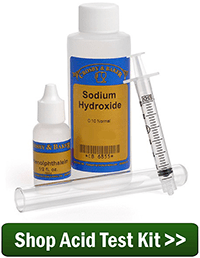 Hi, I followed a recipe for blueberry wine that called for 15 pounds of sugar and 20 pounds of frozen blueberries for a 6 gallon batch. I just measured it with my wine hydrometer and got a reading of 1.148 ! I know this starting specific gravity is too high. Is there anything I can do other than hope for the best ? I am new to wine making and have no idea ?
Hi, I followed a recipe for blueberry wine that called for 15 pounds of sugar and 20 pounds of frozen blueberries for a 6 gallon batch. I just measured it with my wine hydrometer and got a reading of 1.148 ! I know this starting specific gravity is too high. Is there anything I can do other than hope for the best ? I am new to wine making and have no idea ?
Marshall S. – IA
—–
Hello Marshall,
Well, that’s an interesting wine recipe. The starting specific gravity reading you got on your hydrometer, does make since with that much fruit and sugar being added. The bad news is that the odds of a fermentation even starting at that high of a specific gravity reading is very low. When the concentration of sugar gets too high, it starts to act as a preservative, keeping the yeast from fermenting.
The good news is that I think we can fix it. Simply put, your wine’s starting specific gravity is too high, and we need to think about how we can lower it.
 In reality, there are two concerns. The first one is the most obvious: too much sugar for the yeast to start fermenting. That’s what the specific gravity reading is telling – how much sugar. But there is also a concern that there may be too much blueberry – enough to make the wine overly tart and astringent. With that being said, here’s what you can do:
In reality, there are two concerns. The first one is the most obvious: too much sugar for the yeast to start fermenting. That’s what the specific gravity reading is telling – how much sugar. But there is also a concern that there may be too much blueberry – enough to make the wine overly tart and astringent. With that being said, here’s what you can do:
- Dilute the wine must with water until you get a reading of 1.100. If you like, you can use a Pearson square to calculate how much water to add to get from 1.148 to 1.100. (Water has a S.G. of 1.000) There will still be plenty of blueberry flavor to go around. Our blueberry wine recipe only calls for 13 lbs. to 5 gallons, so don’t worry about weakening the wine’s flavor too much. And besides, you really don’t have much choice when your wine’s starting specific gravity is too high. The yeast aren’t even beginning to think about fermenting with that much sugar.
- Take an acid reading with an acid test kit. This will tell you if the blueberries are still providing enough tartness to make the resulting wine taste right. The directions in the acid test kit will tell you what range you are shooting for. My guess if that you will need to add a little Acid Blend after diluting with water to bring the acidity up a bit. But, if the acid level is still too high,
 you will want to dilute the wine must with even more water. Just try to keep your wine’s starting specific gravity above 1.075.
you will want to dilute the wine must with even more water. Just try to keep your wine’s starting specific gravity above 1.075.
- Once you have the sugar level and acidity in a decent range, it’s all smooth sailing. If you haven’t added add yeast nutrient at this point, I most certainly would, now. The same goes for pectic enzyme, and wine tannin. If you got the ingredients from us, you will find recommend dosages on the side of each container.
If you have already added the wine yeast you can still do all of the above. The yeast will be fine. If you have not, be sure to use and actual wine yeast. Don’t add a bread yeast.
Once you’ve got the specific gravity and acidity level ironed out, you will continue on like you normally would with any winemaking process. Here’s an wine making infographic that lays out the basic steps for you.
Hope this information helps you out. I urge you to do the above steps. Don’t dump it out. Nothing you have done or will do in the above steps will compromised this wine in any way, so it will be well worth the effort. Believe me, you are not that only one that’s ran into this problem. Many home winemaker’s have gotten their wine’s starting specific gravity too high. Just take things a step at a time and your wine will be out of the woods.
this wine in any way, so it will be well worth the effort. Believe me, you are not that only one that’s ran into this problem. Many home winemaker’s have gotten their wine’s starting specific gravity too high. Just take things a step at a time and your wine will be out of the woods.
I would like to welcome you to take a look at our wine recipes that are free for anyone to use. These a solid, time-tested wine recipes that will keep you out of trouble in your future wine making adventures.
Happy Wine Making,
Ed Kraus
—–
Ed Kraus is a 3rd generation home brewer/winemaker and has been an owner of E. C. Kraus since 1999. He has been helping individuals make better wine and beer for over 25 years.

I am in the process of making wine with small black grapes (muscadine). I started the process on 09-14-2016 with a SG of 1.126. On 10-02-2016 the SG was 1.062. The fermentation has slowed drastically. I do not believe it will go much lower. In the past I have started at this SG and it would stop in the 1.015/1.025 range which I like for a sweet wine. Your help in solving my problem would be greatly appreciated. Thanks.
James, your starting gravity was a little too high so the yeast is struggling to complete the fermentation. There could also be other factors contributing to the sluggish progress. This will all be discussed in the article posted below.
Too Much Sugar
http://www.eckraus.com/blog/too-much-sugar-in-primary-fermentation
do it by brix, not gravity.
In reference to , to high a S.G. Ed I have a question I would love your opinion on. I have been doing fruit wines for some period of time. I have been taught by some old hats to freeze every kind of fruit. After weighing out of course. The freezing really breaks down the fruit and releases the sugar and juice. After the initial fermentation there is nothing left in the fermentation bag but skins. when I do the wines a lot of times my S.G starts out really high. My habit has become a way to increase the Alcohol volume. By removing a gallon of the sweet must and adding a gallon of spring water prior to the yeast being pitched. This makes a workable S.G.. After initial fermentation. The must bag is removed and racked off the initial sediment. The removed must is readded. Topped off airlock added and allowed to ferment to dry. Upon an S.G. reading under 1.000 I will degas and add sulfite ,sorbate and back sweeten. Add clarifier let sit for 10 days under airlock to be sure fermentation doesn’t begin again. Rack into primary and bottle from there. I have been able to accomplish this in only a few months without a bunch oh ageing. I guess that’s ok? Your comments on this would be cherished.. TY
Jim, when someone is trying to make a higher alcohol wine, it is recommended that you add any additional sugar to raise the PA gradually after the initial sugar has fermented down some. This method is so the yeast does not have to work so hard or you do not experience a stuck fermentation.This is basically what you are doing so I see nothing wrong with doing what you have been doing.
My initial gravity was close to 1.12 and that was 30 days ago. I made a cherry wine with 25lbs of cherries and 12 pounds of sugar. It gassed feverishly for the first 10-14 days – now, nothing. Gravity is stuck at 1.10. Added 2 more pounds of sugar and two bottles of Just Cherry Tart juice to sweeten it a bit – it tasted like rubbing alcohol at first. Should I drain some of it and add water now or just let it sit in my carboy for another month or two or three or….?
Thanks.
Eric, before you bottle the wine you need to make sure the fermentation is complete by reaching a specific gravity reading of.998 or less. There are a number of reasons that can cause a fermentation to become stuck before completion. Before you can fix the problem, you need to know the cause. It is possible that the reason this happened is due to too much sugar so you might need to add water.
Top Reasons For Fermentation Failure
http://eckraus.com/wine-making-failure/
I will give that a shot. I currently have my 6 gallon carboy close to the neck (full) – Can empty about 2 gallons into my 3 gallon carboy and then add some 70 degree water – will see if that changes anything. I sure hope the taste is not diluted in the end. If it is, I will add more cherry juice from Just Cherry. Thanks!!
I started a batch of fig wine and accidentally added more sugar than the recipe (https://eckraus.com/content/figwine.pdf) called for. See my log below. After 1.5 months of “fermentation”, the solution is clear, the airlock makes an occasional bubble once in a few hours, but the SG is 1.030. It seems like the fermentation has failed. I feel really sorry for all the work and ingredients 🙁 Is there anything I can do to save this batch?
The Log
Sep 17, 2019
Added to primary fermenter:
– 18 lbs. of chopped fresh figs
– 2 tbsp. Yeast Nutrient
– 1⁄2 tsp. Pectic Enzyme
– 4 tbsp. Acid Blend
– 1⁄2 tsp. Wine Tannin
– 5 crushed Campden Tablets
– MISTAKENLY added 10 lbs. of sugar instead of 9 lbs.
– Added water to equal the batch to 5 gallons
Sep 18, 2019
Added to primary fermenter:
– 1 Packet of Wine Yeast: K1V-1116
Oct 2, 2019
Removed fig must. Siphoned into a carboy. Specific Gravity: 1.040. There was little to no frothing activity in the next couple of weeks
Nov 17, 2019.
Specific Gravity: 1.030
Vince, The one extra pound of sugar should not be an issue at all. I suspect something else is causing this slow fermentation. To correct the problem, you need to find out the cause first. Please take a look at the article posted below on the most common causes of fermentation failure.
Top Reasons Foe Fermentation Failure
https://eckraus.com/wine-making-failure/
What is the best way to add sugar to a dry wine just prior to bottling.
It is best to pre-dissolve the sugar in water first. Heat up 2/3 sugar and 1/3 water in a sauce pan. Stir continuously until dissolved. Let it cool before adding to the wine.
It is also important to understand that anytime you back-sweeten a wine, you need to add potassium sorbate as well. We recommend 1/2 teaspoon per gallon. This is to help make sure the fermentation does not start up again with the newly added sugars.
Hi Ed,
In your reply to Marshall you recommend 13 lb fruit to 5 gallons. I started making fruit wine 45 years ago and have made them since even growing a specific variety of blueberry and using a specific strain of yeast to get the taste I want. It took several years of experimentation, which is part of the fun of making my own wine. I found that 5 lb of fruit per gallon gives me the rich taste I desire, a little more fruit for peaches and apples. I mention this for those that may find 13 lb per 5 gallons does not provide the complexity and mouthfeel they strive for.
As you mentioned I usually have to adjust acidity, sugar and water to get the starting point correct. This varies every year depending on the variety of blueberry and the temperature/rainfall in the year. A few side experiments in glass measuring cups and use of Pearsons square helps me home in quickly. The experimentation with variety of fruit and yeast is the fun about making our own wines.
Also, I use the freeze method that Jim mentions above to release juice but still also add some pectic enzyme at the beginning.
Hope this helps those just beginning their wine making journey and that they enjoy the experimentation.
I’m sorry i have to laugh. I have been reading all these post telling people that they add to much sugar for wine. Granted, I learned to make wine in prison. got out, started making it my own way. I use regular fruit juice. to be exact, Pineapple Juice. My last batch used this
5 gallons of Pineapple Juice from the dollar store
12 lbs of sugar from the dollar store
2 packets of bread yeast ( would’ve prefered wine yeast but didn’t have it).
now I don’t know what my starting hydrometer reading was considering i didn’t have one at the time. but i’m pretty sure it was WAY above what you say it should be. HOWEVER, within 3 weeks it was already down to 1.010 (used my neighbors hydrometer) and by next week it was at .90 but still had a nice pleasant taste to it, instead of being sour. BOY OH BOY could you taste the alcohol in it.
Now this batch on the other hand is taking a little longer. this is a cran-pineapple 7 gal with 16lbs of sugar and 1 month in is now down to 1.126 from a starting of well lets just say it was too high. yes it is going slower then normal but it is still going. is NOT stuck! i check it every other day. and is actually speeding up. within the next week or two should prolly be done.
oh also NO i never split my batches nor do i EVER add water! my neighbor keeps wanting to run my wine through his still but i haven’t decided to go that route yet. just because you add too much sugar doesnt mean your batch wont come out, or it will get stuck. just means you gotta baby it, add nutrients, and keep an eye on it. i mix mine up EVERYDAY without opening it up. i use a fastfermentor mounted on the wall. so i just give it a nice shake back and forth to mix it up until it starts a foam cake then stop. i NEVER take the lid off unless i do a hydrometer reading.